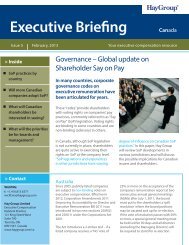a PDF summary of the technology convergence - Hay Group
a PDF summary of the technology convergence - Hay Group
a PDF summary of the technology convergence - Hay Group
You also want an ePaper? Increase the reach of your titles
YUMPU automatically turns print PDFs into web optimized ePapers that Google loves.
Leadership 2030 | The future <strong>of</strong> leadership<br />
Technology<br />
<strong>convergence</strong><br />
Harnessing <strong>technology</strong> to innovate<br />
The nature <strong>of</strong> leadership will have to change dramatically if organizations are to harness<br />
<strong>the</strong> benefits and counter <strong>the</strong> negative effects <strong>of</strong> <strong>the</strong> six megatrends identified by <strong>Hay</strong><br />
<strong>Group</strong> as likely to have <strong>the</strong> greatest effect on organizations and <strong>the</strong>ir leaders over <strong>the</strong><br />
coming decade. Here we examine <strong>the</strong> organizational and leadership implications <strong>of</strong> one<br />
<strong>of</strong> <strong>the</strong>se megatrends, <strong>technology</strong> <strong>convergence</strong> >><br />
Miniaturization and virtualization will drive <strong>the</strong><br />
<strong>convergence</strong> between nano-, bio- and information<br />
technologies and cognitive sciences, spurring innovation<br />
and accelerating research and development in many<br />
fields. ‘NBIC’ technologies are already driving rapid<br />
advances in medicine, energy, environmental protection<br />
and production processes, and <strong>the</strong>ir potential for<br />
transforming o<strong>the</strong>r areas is huge.<br />
©2011 <strong>Hay</strong> <strong>Group</strong>. All rights reserved
Technology <strong>convergence</strong>: harnessing <strong>technology</strong> to innovate<br />
Organizational implications<br />
Actionable knowledge <strong>of</strong> complex technologies will<br />
become a key business competence, even in nontechnological<br />
fields. Such knowledge is critical to guard<br />
against <strong>the</strong> risk that <strong>the</strong> focus on marketable results might<br />
come at <strong>the</strong> expense <strong>of</strong> fundamental but costly market<br />
research. Indeed, <strong>the</strong> complexity <strong>of</strong> NBIC makes intercorporate<br />
knowledge exchange vital, and ‘business mashups’<br />
(collaborations and cross-sector partnerships) will<br />
become more common. Companies will have to adapt to<br />
survive, and <strong>the</strong>ir readiness to integrate o<strong>the</strong>r players in<br />
corporate endeavors will lead to more open structures and<br />
de-compartmentalized organizations – and, ultimately,<br />
converging markets.<br />
leaders must know enough<br />
to be able to recognize<br />
and evaluate <strong>the</strong> potential<br />
<strong>of</strong> any new <strong>technology</strong><br />
Leadership implications<br />
Despite <strong>the</strong>ir lack <strong>of</strong> detailed knowledge, leaders must be<br />
open to – and advocates <strong>of</strong> – visionary ideas, encourage<br />
innovation and collaboration and act as orchestrators <strong>of</strong><br />
expertise from within and outside <strong>the</strong> organization in order<br />
to harness <strong>the</strong> potential <strong>of</strong> converging technologies. They must<br />
be open to value-adding partnerships on all levels, and <strong>the</strong><br />
decision to build or buy expertise will become a key issue in<br />
R&D management. Leaders may not be experts <strong>the</strong>mselves,<br />
but <strong>the</strong>y must know enough to be able to recognize and<br />
evaluate <strong>the</strong> potential <strong>of</strong> any new <strong>technology</strong>, to act as<br />
mediators between collaborating institutions and scientific<br />
fields, to keep projects focused and to hold <strong>the</strong> ring between<br />
<strong>the</strong> competing views <strong>of</strong> different team members. In doing<br />
so, <strong>the</strong>y will have to work through informal influence across<br />
functional and organizational boundaries. This requires <strong>the</strong>m<br />
to collaborate, to welcome different points <strong>of</strong> view, to tolerate<br />
ambiguity and to create and role-model trust and openness.<br />
It is also crucial that <strong>the</strong>y help to counter concern and<br />
anxiety among both <strong>the</strong> public and employees about<br />
<strong>the</strong>se new technologies, because <strong>the</strong>ir acceptance will<br />
increasingly determine <strong>the</strong> success or failure <strong>of</strong> innovations<br />
and new products.<br />
About <strong>Hay</strong> <strong>Group</strong><br />
<strong>Hay</strong> <strong>Group</strong> is a global consulting firm that works with<br />
leaders to turn strategies into reality. We develop<br />
talent, organize people to be more effective and<br />
motivate <strong>the</strong>m to perform at <strong>the</strong>ir best. Our focus is<br />
on making change happen and helping people and<br />
organizations realize <strong>the</strong>ir potential.<br />
We have over 2600 employees working in 84 <strong>of</strong>fices<br />
in 48 countries. Our clients are from <strong>the</strong> private,<br />
public and not-for-pr<strong>of</strong>it sectors, across every<br />
major industry.<br />
To find out more about how to prepare your<br />
organization for <strong>the</strong> leadership challenges that lie<br />
ahead, contact your local <strong>Hay</strong> <strong>Group</strong> <strong>of</strong>fice through<br />
www.haygroup.com<br />
©2011 <strong>Hay</strong> <strong>Group</strong>. All rights reserved

















